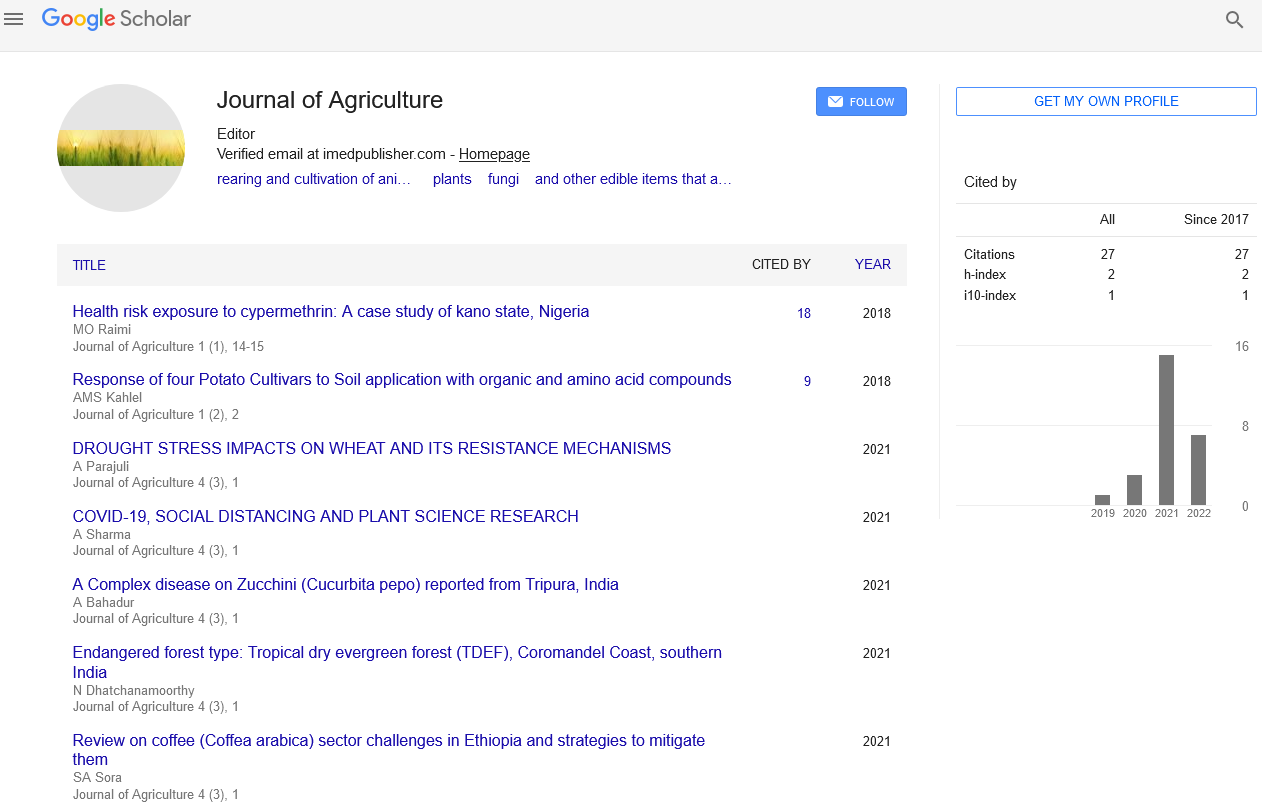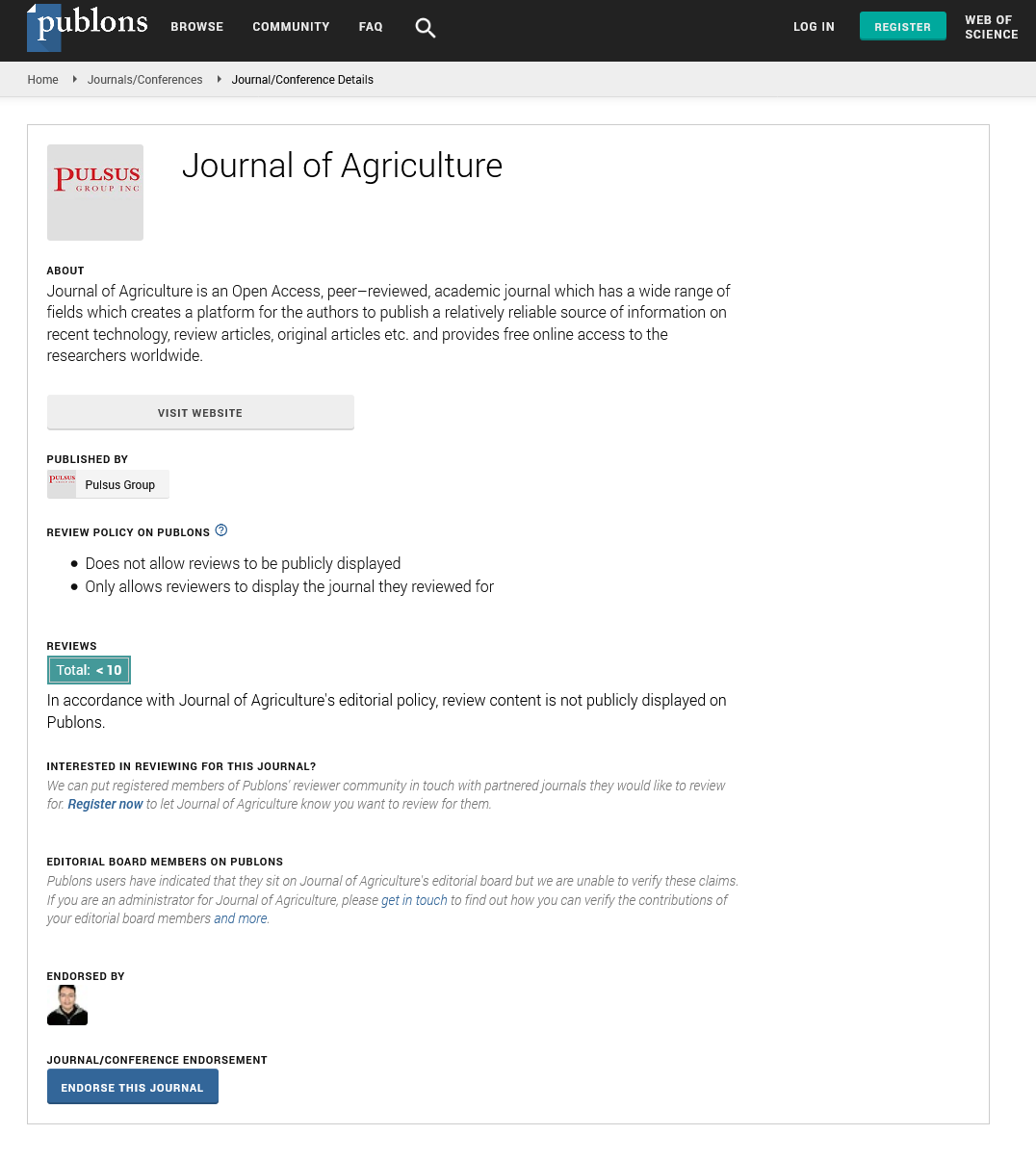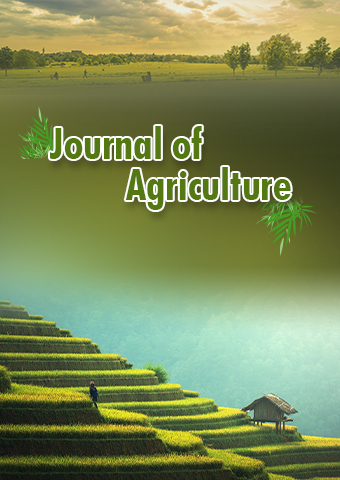Editorial - Journal of Agriculture (2023) Volume 6, Issue 3
Advancements in Plant Breeding: Pioneering Sustainable Agriculture
Lehn Sharma*
Department of Agriculture, Agricultural University, India
Department of Agriculture, Agricultural University, India
E-mail: Lehensharma45@gmail.com
Received: 31-May-2023, Manuscript No. jagri-23-104427; Editor assigned: 02-Jun-2023, Pre-QC No. jagri-23-104427 (PQ); Reviewed: 16- Jun-2023, QC No. jagri-23-104427; Revised: 21-Jun-2023, Manuscript No. jagri-23-104427 (R); Published: 28-Jun-2023, DOI: 10.37532/ jagri.2023.6(3).85-87
Abstract
Plant breeding plays a crucial role in ensuring food security, increasing agricultural productivity, and mitigating the challenges posed by a changing climate. This abstract provides an overview of the significant advances in plant breeding techniques and strategies aimed at harnessing genetic diversity for sustainable crop improvement. Traditional plant breeding methods have been augmented by technological advancements, enabling breeders to access and utilize the rich genetic diversity present in crop species. The advent of high-throughput DNA sequencing has revolutionized plant breeding by facilitating the identification and characterization of genes responsible for desirable traits. This knowledge enables breeders to develop improved cultivars with enhanced yield potential, disease resistance, stress tolerance, and nutritional quality. Genomic selection and marker-assisted breeding are powerful tools that accelerate the breeding process. These techniques allow breeders to identify and select plants with desired traits at the early stages of development, reducing the time required for conventional breeding programs. Marker-assisted breeding employs molecular markers linked to specific genes or traits, facilitating their efficient transfer across diverse genetic backgrounds. The emergence of advanced molecular breeding techniques, such as gene editing (e.g., CRISPR-Cas9), has opened up new avenues for precise manipulation of plant genomes. Gene editing offers the potential to introduce targeted genetic modifications, including gene knockouts, knock-ins, and gene replacements, resulting in the development of improved crop varieties. However, ethical and regulatory considerations surrounding the use of gene editing in crop breeding remain subjects of on-going debate. Another important aspect of modern plant breeding is the incorporation of genomic information from wild relatives and landraces. These genetic resources harbour a vast array of traits that can be transferred to cultivated crops to enhance their adaptability and resilience to changing environmental conditions. Utilizing genetic diversity in breeding programs helps reduce vulnerability to pests, diseases, and abiotic stresses, ensuring long-term sustainability of agricultural systems. Plant breeding has made significant strides in recent years, fueled by advances in genomics and molecular biology.The integration of cutting-edge techniques, such as high-throughput sequencing, genomic selection, marker-assisted breeding, and gene editing, has revolutionized the field. By harnessing the natural genetic diversity of crops and incorporating traits from wild relatives, breeders are developing improved cultivars that contribute to global food security, agricultural sustainability, and the resilience of farming systems in the face of environmental challenges
Keywords
Plant breeding • Agricultural productivity • Genetic diversity • Genomics
Introduction
Plant breeding is a fundamental discipline within agriculture that plays a pivotal role in the development of new and improved crop varieties. Over the years, significant advancements have been made in this field, leading to the production of high-yielding, disease-resistant, and climate-resilient plant varieties. These advancements not only enhance agricultural productivity but also contribute to the sustainability and food security of our planet. In this article, we will explore the key techniques and innovations in plant breeding, highlighting their impact on modern agriculture and their potential to address future challenges [1].
Traditional breeding methods
Traditional plant breeding involves the selection and cross-pollination of desirable traits in plants to obtain improved offspring. Breeders select parent plants based on their desired characteristics, such as higher yields, disease resistance, or enhanced nutritional value. By crossbreeding these plants, breeders create genetic diversity and evaluate the resulting progeny to identify individuals with the desired traits. This process is repeated over several generations to achieve stable and improved varieties [2, 3].
Hybridization
Hybridization is a technique that involves crossing two genetically diverse parent plants to obtain offspring with improved characteristics. Hybrids often exhibit higher yields, improved disease resistance, and better adaptability to specific environmental conditions [4]. The phenomenon of hybrid vigor, also known as heterosis, occurs when the hybrid offspring outperform their parents in various traits, leading to increased productivity.
Molecular breeding
Molecular breeding techniques, such as marker-assisted selection (MAS) and genetic engineering, have revolutionized plant breeding by enabling more precise and efficient trait selection. MAS involve identifying genetic markers linked to desirable traits and using them as indicators during the selection process. This approach allows breeders to select plants with desired traits at an early stage, saving time and resources. Genetic engineering, on the other hand, involves the direct manipulation of an organism’s genome to introduce specific traits. This technique has led to the development of genetically modified (GM) crops with enhanced traits, such as pest resistance or improved nutritional value [5, 6].
Genomic selection and big data
With the advent of high-throughput sequencing technologies, genomics has become an integral part of plant breeding. Genomic selection involves analysing the entire genome of plants to predict their breeding values accurately. By using statistical models and machine learning algorithms, breeders can select plants with desired traits more efficiently [7]. The integration of big data analytics, including genotypic and phenotypic data, allows breeders to make informed decisions and accelerate the breeding process.
Precision breeding
Precision breeding techniques, including gene editing using CRISPR-Cas9, offer great potential for accelerating crop improvement. CRISPR-Cas9 allows breeders to precisely modify specific genes, enhancing or suppressing their expression to achieve desired traits. This technology provides a more targeted and efficient approach compared to traditional genetic engineering methods, as it does not require the introduction of foreign genes [8].
Climate-resilient and sustainable varieties
Climate change poses significant challenges to global agriculture. To mitigate its impact, plant breeders are focusing on developing climate-resilient varieties that can withstand drought, heat stress, and other extreme conditions. By integrating traits such as heat tolerance, water-use efficiency, and disease resistance, breeders aim to create crops that can thrive in changing environments while reducing the need for chemical inputs [9, 10].
Conclusion
Plant breeding continues to evolve and contribute to sustainable agriculture by developing crop varieties that address the challenges of a changing world. Traditional breeding methods, along with molecular breeding techniques and precision breeding tools, have paved the way for the creation of high-yielding, resilient, and sustainable plant varieties. With on-going research and technological advancements, plant breeders are well-positioned to tackle future agricultural and environmental challenges, ensuring global food security.
References
- Podevin, Nancy, Yann Devos et al. Transgenic or not? No simple answer! New biotechnology‐based plant breeding techniques and the regulatory landscape.EMBO reports.13, 1057-1061(2012).
- Ammann, Klaus. Genomic misconception: a fresh look at the biosafety of transgenic and conventional crops. A plea for a process agnostic regulation. New biotechnology.31.1, 1-17(2014).
- Ricroch, Agnes.Challenges facing European agriculture and possible biotechnological solutions.Critical Reviews in Biotechnology.36.5, 875-883(2016).
- Nakka S, Jugulam M, Peterson D et al. Herbicide resistance: development of wheat production systems and current status of resistant weeds in wheat cropping systems. Crop J.7,750–60(2019).
- Martin-Laffon J, Kuntz M, Ricroch Ae. Worldwide CRISPR patent landscape shows strong geographical biases. Nat Biotechnol.37,613–20(2019).
- Menz J, Modrzejewski D, Hartung F et al. Genome edited crops touch the market: a view on the global development and regulatory environment. Front Plant Sci. 11,586027 (2020).
- Cao X, Dong Z. Development and characterization of marker-free and transgene insertion site-defined transgenic wheat with improved grain storability and fatty acid content. Plant Biotechnol J.18,129–40(2020).
- Eriksson D, Custers R, Edvardsson Bjornberg K et al. Options to reform the European Union legislation on GMOs: postauthorization and beyond. Trends Biotechnol.38, 465–7(2020).
- Lusser M, Parisi C, Plan D et al. Deployment of new biotechnologies in plant breeding.Nature biotechnology.30, 231-239(2012).
- TA, Hayes TR, Cranmer AC et al. Genetic engineering of a quantitative trait: metabolic and genetic parameters the accumulation of laurate in rapeseed. The Plant Journal. 9, 229-241(1996).
Indexed at, Google Scholar, Crossref
Indexed at, Google Scholar, Crossref
Indexed at, Google Scholar, Crossref
Indexed at, Google Scholar, Crossref
Indexed at, Google Scholar, Crossref
Indexed at, Google Scholar, Crossref
Indexed at, Google Scholar, Crossref
Indexed at, Google Scholar, Crossref
Indexed at, Google Scholar, Crossref


